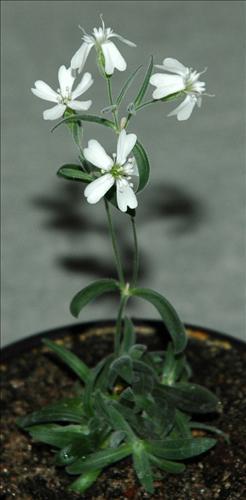 |
Flowers from Silene stenophylla plant, which was regenerated after 31,800 years. (PNAS-Yonhap News) |
Fruit seeds stored away by squirrels more than 30,000 years ago and found in Siberian permafrost have been regenerated into full flowering plants by scientists in Russia, a new study has revealed.
The seeds of the herbaceous Silene stenophylla plant, whose age was confirmed by radiocarbon dating at 31,800 years old, are far and away the most ancient plant material to have been brought back to life, said lead researchers Svetlana Yashina and David Gilichinsky of the Russian Academy of Sciences.
The previous record for viable regeneration of ancient flora was with 2,000-year-old date palm seeds near the Dead Sea in Israel.
The latest findings could be a landmark in research of ancient biological material, and highlight the importance of permafrost in the "search of an ancient genetic pool, that of preexisting life, which hypothetically has long since vanished from the earth's surface," they wrote.
The study, to appear in Tuesday's issue of Proceedings of the National Academy of Sciences, described the discovery of 70 squirrel hibernation burrows along the bank of the lower Kolyma river, in Russia's northeast Siberia, and bearing thousands of seed samples from various plants.
"All burrows were found at depths of 20-40 meters from the present day surface and located in layers containing bones of large mammals such as mammoth, woolly rhinoceros, bison, horse, deer, and other representatives of fauna" from the Late Pleistocene Age.
Scientists were able to grow new specimens from such old plant material in large part because the burrows were quickly covered with ice, and then remained "continuously frozen and never thawed," in effect preventing any permafrost degradation.
In their lab near Moscow, the scientists sought to grow plants from mature S. Stenophylla seeds, but when that failed, they turned to elements of the plants' fruit, which they described as "placental tissue," to successfully grow regenerated whole plants. (AFP)
<관련 한글 기사>
"쥬라기공원 기적!" 3만년전 식물 살아나
만여년 전 시베리아 지역에서 다람쥐가 굴 속에 감춰놓은 덜 익은 열매가 과학자들의 혁신적인 실험으로 다시 꽃을 피우고 열매를 맺었다.
매머드 화석 유적지인 시베리아의 콜미아강 둑에서 석죽과 식물 실레네 스테노 필라(Silene stenophylla)의 열매를 발견한 러시아 세포생물물리학 연구소 과학자들 은 이 열매의 조직을 이용해 꽃을 피우고 번식력 있는 열매를 맺게 하는데 성공했다 고 BBC 뉴스와 라이브사이언스 닷컴이 20일 보도했다.
이 연구는 미국립과학원회보(PNAS) 최신호에 발표됐다.
지금까지 고대 식물을 되살려 낸 사례로 가장 오래 된 것은 이스라엘 마사다에 서 발견된 2천년 전 야자 씨앗이며 중국 과학자들은 1천300년 전 연꽃 씨앗으로 꽃을 피워내기도 했다.
연구진은 3만년 전 표토층이었던 지하 20~40m 지층에서 동결 상태를 유지해 온 다람쥐 굴 70여개와 그 안에 저장된 수많은 씨앗과 열매를 발견했다. 방사선 연대측 정 결과 이들 식물의 연대는 3만2천~2만8천년 전으로 나타났다.
학자들은 처음엔 씨앗을 이용해 옛 식물을 되살리려고 노력했으나 실패하자 동 물로 치면 `태반조직'과 같은 열매의 조직을 채취해 배양액에서 키웠다. 이 열매 조 직의 세포들은 식물의 모든 부위로 자랄 수 있는 능력을 갖고 있다.
배양액 속에서 조직이 싹을 틔우자 연구진은 이를 일반 토양에 옮겨 심었고 묘 목은 잘 자라 꽃을 피우고 번식력 있는 열매까지 맺었다.
연구진은 대부분의 식물 씨앗은 몇년 안에 죽지만 1천300년 전의 연꽃이나 S.스테노필라처럼 생명력이 강한 종들은 식물의 DNA를 보존하거나 수리하는 자체 메커니 즘을 갖고 있다고 지적했다.
이들은 이런 놀라운 식물의 사례를 통해 사람이 어떻게 DNA를 수리해 암을 예방 할 수 있을 지 등을 연구할 수 있을 것이라고 말했다.
다람쥐 굴이 발견된 지층은 매머드와 털코뿔소, 들소, 말, 사슴 등 대형 포유동 물의 뼈들이 묻혀 있는 층 아래 쪽에 위치해 있으며 축구 공 크기의 굴들은 맨 밑에 마른 풀, 그 위엔 동물의 털 등이 깔려 있어 천연 저장고 역할을 한 것으로 보인다.
학자들이 되살려낸 식물은 지금도 시베리아 툰드라 지대에서 자라고 있는 것과 크게 다르지 않은 것으로 밝혀졌다.
연구진은 이런 종류의 실험이 식물의 진화 과정과 과거의 환경을 밝히는데 도움 이 될 것이며 고대 표본이 존재할 경우 멸종한 식물도 되살려낼 수 있을 것이라고 말했다. (연합뉴스)








![[Today’s K-pop] Blackpink’s Jennie, Lisa invited to Coachella as solo acts](http://res.heraldm.com/phpwas/restmb_idxmake.php?idx=644&simg=/content/image/2024/11/21/20241121050099_0.jpg)